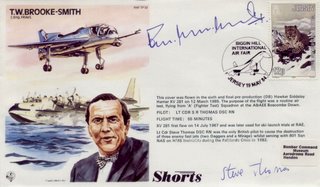Brooke-Smith with Mr D Scard, Shorts Chief Flight Test Observer discussing the maiden flight of the first Shorts-built Canberra B2 WH853 on 30th October 1952.



Tom Brooke-Smith was a jovial larger than life figure and his exploits spanned the pre war period of flying for fun and the Jet age. One of the leading experimental fliers of his time. Brooke Smith was the first pilot to make a jet powered vertical take off in a fixed with aircraft, then translate into aerodynamic flight and return to the hover for the vertical landing. As Chief Test Pilot for Short Brothers of Belfast he was told that the company had received contracts for two SC1 Delta Wing experimental vertical take off and landing aircraft. It struck him that he was, as he put it "on a collision course with Sir Isaac Newton". His initial step was to learn to fly a helicopter, he had gone solo by teatime on the first day. Eventually on April 6th 1960 after 4 years experimental work with his team he fired the lift engines which lit, he noted "like the top of a gas cooker" He had in short pioneered VTOL flight and that year the aviation world paid tribute to him when he demonstrated it at the Farnborough Air Show.
A Fenland farmers son he was born on August 14th 1918. His grandfather had introduced the King Edward potato. At the age of 4 he was much impressed by the sight of a helmeted pilot, who had landed in one of his fathers fields in order to ask the way! As a pupil at Bedford School he would eagerly bicycle to watch the flying at the airship station at Cardington and at RAF Henlow. He began to learn to fly at Brooklands in his teens and at 16 left Bedford to study aeronautical engineering at Chelsea College. The day after his 17th Birthday he went solo. After logging 250 hours he joined the Hope air taxi company at Croyden and subsequently moved to Air Despatch, the enterprise owned by the pioneer aviatrix Mrs Victor Bruce. On the outbreak of the 2nd World War in 1939 civil airlines were directed to war tasks and Brooke Smith spent that winter flying equipment to France in De Havilland Dragons When the Battle of Britain began in 1940 he was recruited by Air Transport Auxiliary. Within two days he had flown deliveries of a Miles Master, Lysander, Spitfire and Hurricane, although he had never been in any of their cockpits before.
Brooke Smiths "big break" as a test pilot came in 1941 after he had ferried Stirling Bombers from the Short factory in Belfast. Shorts snapped him up to test Stirlings and Sunderland flying boats as they came off the production line. By the age of 23 Brookie had flown 83 different aircraft types. He had a runabout of his own a Short 31, half scale four engined Stirling. He did not formally qualify as a test pilot until after the war in 1947, when he passed the arduous course at the Empire Test Pilots School. The next year he returned to Shorts as Chief Test Pilot. Soon he was facing up to the challenge of the SB1. This was a tail-less glider built in 1951 to experiment with a crescent shaped isoclinic wing design, and with moving wing tips controls, characteristics considered helpful at the time, toward producing a future V Bomber design. He was also much involved with the Sperin, a bomber developed in case the Valiant, Vulcan and Victor V Bombers failed. Many of his ideas were taken into the design and he was greatly disappointed when the Valiant was selected as the RAF's first V Bomber and only two Sperrins were built But it was the tail-less glider which dealt Brookie the greatest blow of his career. He was testing it when the machine went out of control hit a runway at Aldergrove, near Belfast at more than 100 mph and smashed into pieces. He suffered severe spinal injuries and spent months in hospital. From his bed he recommended rebuilding the machine and suggested that this time it should be powered with two mini jet engines. It was called the Sherpa and handled well, but the isoclinic experiment was abandoned. Then came the vertical take off and landing breakthrough. After his triumphant demonstration at Farnborough in 1960 he intended to retire & was not even planning to fly the aircraft away from the show. In the event, however he was the only experienced pilot available. After the aircraft had refuelled at Boscombe Down, three tyres burst simultaneously on take off and only Brooke Smiths exceptional skill and experience averted disaster. At the Air League Ball that year he was presented by the Duke of Hamilton with a pair of number plates for his motor car bearing the proud legend "1 VTO". Next he transferred his presentational skill to the world of public relations. He ran his own company and was also group public relations executive for Flight Refuelling. He was elected a Fellow of the Royal Aeronautical Society in 1961, held the Derry and Richards Memorial Medal
for his experimental test flying, the Britannia Trophy, the Segrave Trophy, and the Founders Medal of the Air League of the British Empire, and was a former master of the Guild of Air Pilots and Navigators.



